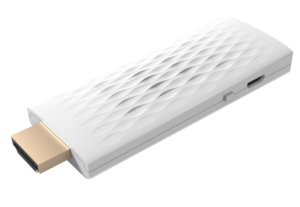Some of the greatest inventions used every day began by answering a “what if” scenario. What if a pocket-sized device had the potential to explore the relationship between mobile devices and high-definition television?
Eric Hamilton conceived his creation this way. “We have cellphones that are 10 to 15 times more powerful than most computers from 20 years ago,” he said. “I wanted to create something that could unlock the power of the cellphone so that you can use it with your television or for gaming without having to add to your current billing plan.”
Hamilton, an alum of Michigan State University, had been trying to figure out what this device would look like over the course of the last two years. A mentor of the marketing professional told him that instead of searching for this type of device in the marketplace, he should just build it himself.
“So, googled a manufacturing company in China, told them what I wanted, and that’s how it all started,” he said.
Tinystic was born. The device, which is the size of a USB flash 
Tinystic is compatible with Android platforms 4.2 or higher as well as iOS devices (iPhone or iPad). “You can use it to display your mobile apps, games and Excel presentations,” said Hamilton. “Its competitor is Google Chromecast.”
The New York City resident said that, unlike Chromecast, Tinystic can safely stream Spuul, an app that allows viewers access to Bollywood films and Popcorn Flix, another movie app. The device retails at www.tinystic.com for $99 and ships for $8.
This isn’t Hamilton’s first time launching a tech business. The 45-year-old was co-founder of the Around the Way app, a software using Google technology to locate Black-owned businesses. “What separates Tinystic from the Around the Way app is that this is completely under my control,” he said. “The app was free, so the hope was that it would generate revenue on the back end through advertising. With Tinystic, it’s generating revenue upfront with sales.”
The Around the Way app received the endorsement from the United States Black Chamber of Commerce and had great potential for expansion. However, activity on the app has been dormant for over a year. In fact, the last update on the company’s website by its founder Janine Hausif was in April 2014.
Though Hamilton has no ill will toward his previous business acquaintances, he amicably parted ways with them to begin a crowdfunding campaign last August that raised $19,000 toward the manufacturing of Tinystic. He also committed $67,000 in purchase orders from prospective users and investors alike who believed in his dream. Since December, nearly 700 consumers use the device in their homes, on the hotel television while away on business or in the office.
Hamilton has been in talks with a retail mobile marketing firm based in Norcross, Georgia, Tokova, LLC, to help get Tinystic into retail stores. “Maybe we could have a marketing campaign where the customer can sign up for a certain cellphone plan and receive Tinystic for free,” he said. “Cellphone technology has made the world smaller.”
TinyTV is the next product Hamilton is in the process of developing. The new device will have the potential to transmit television waves into the user’s cell so that he or she is able to watch network shows on a cellphone. “If you’re in Atlanta, the signal will probably be stronger,” he said. “If you’re in a desert, the signal may not be strong enough to work.”
Hamilton said that he looks forward to getting Tinystic partnered with mobile retailers by the end of the year, and launching TinyTV by next year.

